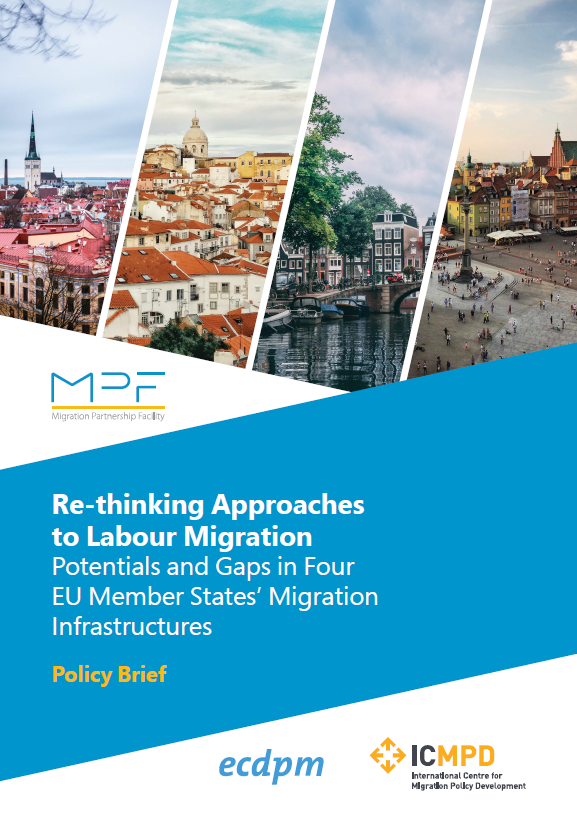Re-thinking Approaches to Labour Migration - Potentials and Gaps in four EU Member States’ Migration Infrastructures
All publications can be downloaded here.
Europe’s working-age population is declining. Employers in EU member states face large and persistent skill and labour shortages in a range of high- and mid-skill professions and in diverse sectors ranging from construction over care to information technology. Against a background of growing economic needs, the recruitment of foreign workers to the EU has increased in importance as one of the strategies to fill labour market shortages. At the same time, migration remains a sensitive political topic and levels of socio-political acceptance for an increase in labour immigration varies across member states.
The EU has developed the framework for Talent Partnerships (TPs) to respond to these dynamics. TPs are presented as a policy tool that can help member states to benefit from international mobility and to better match labour market needs with foreign skills. How to utilise and advance the TPs within the context of national migration systems is however not always obvious. It requires not only legal migration systems that can provide for efficient and effective access to legal migration routes but also a link between labour market assessments and the identification of current and future migration needs as well as information on skill profiles of partner countries.
The MPF and ECDPM have been mapping labour market needs and analysed national migration systems of four EU member states (Estonia, the Netherlands, Poland and Portugal) with the aim to investigate how prepared the respective infrastructures are to respond to growing needs for workers. We were interested in understanding how existing modalities and labour migration pathways could be utilised pragmatically in the context of establishing Talent Partnerships as well as where gaps and possibilities for adaptations lie.
This policy brief highlights our key findings of the case studies along the following questions:
- For which sectors will labour migration likely play a role in the future to address labour market shortages?
- What shape and form do the different migration systems and existing pathways take and how successful have they been in filling labour market needs?
- Where are gaps and what are possible steps for adapting labour migration systems?
The findings of our mappings show that there are growing needs for skills, knowledge and workers at various skill levels. With demographic changes and changing economies these may become more profound in the coming decades. Socio-political acceptance of an increase in labour migration however differs and will play an important role in shaping future approaches to labour migration. Legal migration systems offer a variety of options for labour migrants from third countries to enter the EU member states. And for a number of sectors these work well. Yet, labour migration systems do not always optimally respond to changing economic needs and even if formal migration pathways exist, flanking measures and bureaucratic hurdles can impede their effectiveness. Moreover, data on possible matching countries that would be relevant to choose possible partner countries for Talent Partnerships is missing in a systematic way at the European and EU member states level. Yet, these approaches are not coordinated at the European level leading to several studies and possible duplication of data. Also partner countries’ authorities are faced with several enquiries to share information.
There is a large potential for harmonising and better coordinating across EU member states on labour mobility and migration systems. Especially in the area of collecting and sharing data and information for labour market matching, but also in the area of skills recognition for various sectors. A more harmonised European approach in collecting data and sharing information could be useful to work more efficiently in the context of the Talent Partnership initiative. The recognition of qualifications can be streamlined and simplified at EU-level while paying attention to keeping adequate levels of skills sought.
Shorter digests of each country case study are available, along with an overarching policy brief which analyses the findings from all case studies.
All publications can be downloaded here or through the links below:
- Policy Brief
- Full Case Studies: Portugal, Poland, the Netherlands, Estonia
- Case Study Summaries: Portugal, Poland, the Netherlands, Estonia
- Pathway Overview: Portugal, Poland, the Netherlands, Estonia
See also:
The MPF Labour Mobility Partner Country Dashboard, a complementary tool to this study. While these publications map out information at the EU member states' side, the Partner Country Dashboard provides key migration and labour data of potential partner countries for labour mobility initiatives (currently available: Morocco, Tunisia, Egypt, Nigeria, Senegal, Bangladesh, Pakistan).

